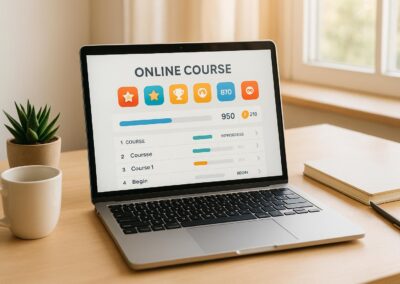Want to create online courses that keep students hooked and help them succeed? Here’s how:
- Use multimedia like videos, audio, and graphics to boost retention by up to 95%.
- Add interactive content like quizzes and hands-on activities to encourage active learning.
- Set clear goals using the SMART framework to guide students effectively.
- Structure your course into short, focused lessons for better understanding.
- Leverage WordPress LMS tools like LearnDash or LifterLMS for easy course creation.
- Track progress and improve using student feedback and analytics.
Quick Comparison of WordPress LMS Tools:
| Tool | Features | Best For |
|---|---|---|
| LearnDash | Quizzes, progress tracking, automation | Organizing structured courses |
| LifterLMS | Member management, content protection | Building community-focused courses |
These strategies will help you design engaging, impactful courses that students will love. Keep reading for a step-by-step guide!
How To Create an Online Course For Beginners
How to Plan Your Course Content
Creating a successful course starts with clear objectives, understanding your audience, and organizing content in a logical way. A well-thought-out plan keeps your materials engaging and helps students succeed.
Setting Clear Learning Goals
Clear, measurable goals are essential. They help students know what to expect and guide your content creation. Consider using the SMART framework: Specific, Measurable, Achievable, Relevant, and Time-bound.
| Goal Component | Example |
|---|---|
| Specific | Develop a social media marketing strategy |
| Measurable | Create campaigns for three platforms |
| Achievable | Using basic tools and templates |
| Relevant | Matches current industry practices |
| Time-bound | Finish within six weeks |
For instance, a SMART goal could be: "Develop and implement a basic social media campaign within six weeks using industry-standard tools" [3].
Know Your Students
Understanding who your students are helps you create content that resonates with them. Research shows that courses tailored to student preferences see better engagement and completion rates [2].
To align with their needs, consider factors like:
- Career goals and professional background
- Preferred learning styles
- Time availability for coursework
- Comfort level with technology
"If you can and are able to record video content, we’re going to start there because video content creates trust." – Mariana Pena, Instructional Designer [3]
Building Your Course Structure
A logical structure is key. Break your content into manageable modules that flow naturally. For example, a web development course might begin with HTML basics, move to CSS styling, and finish with JavaScript.
Keep lessons short and focused – research indicates lessons under 10 minutes improve retention and completion rates [4]. Here’s a simple structure to follow:
- Core Concepts: Start each module with the foundational ideas.
- Hands-On Practice: Include activities to apply what students just learned.
- Checkpoints: Add small assessments to track progress and reinforce knowledge.
Once your structure is set, you can start creating interactive materials to make your course more dynamic and engaging.
Creating Interactive Course Materials
Interactive materials are key to keeping learners engaged, transforming them from passive observers into active participants. Studies indicate that using multimedia can boost knowledge retention by up to 95% compared to plain text content [1][2].
Adding Videos, Audio, and Graphics
Tools like H5P and Canva make it simple to create multimedia content that grabs attention. For instance, H5P allows you to add questions directly into videos, Canva helps you design polished graphics, and Audacity is great for recording audio. To get the most out of these tools: keep videos under six minutes, provide transcripts for audio files, and ensure all visuals match your course branding.
| Media Type | Best Used For | Recommended Tools | Key Considerations |
|---|---|---|---|
| Video | Explaining complex concepts | H5P, Loom | Keep them short |
| Audio | Interviews, language exercises | Audacity, Anchor | Always include transcripts |
| Graphics | Visualizing data, illustrating steps | Canva, Piktochart | Maintain consistent branding |
Using Stories in Teaching
Stories are a powerful way to make abstract ideas more relatable and easier to grasp. For example, when teaching data analysis, you could highlight how Netflix uses viewer data to create hit shows. Effective storytelling ties directly to learning goals, uses examples from relevant industries, and presents real-world problem-solving scenarios. Including student experiences can also make lessons more relatable, but always be mindful of cultural considerations.
Making Effective Quizzes
Quizzes help solidify learning by testing how well students can apply what they’ve learned. Tools like H5P offer a variety of formats, such as drag-and-drop, fill-in-the-blanks, and interactive video questions. Instead of asking generic questions like "What is responsive design?", frame a scenario: "A website looks broken on mobile devices. Which responsive design principles could resolve this issue?"
With interactive materials in place, the next step is to organize your course in a way that simplifies the learning process for students.
sbb-itb-dee25d2
Making Learning Easy for Students
Research indicates that breaking down courses into smaller, structured pieces can boost knowledge retention by as much as 80% [5]. Let’s look at some strategies to simplify learning and keep students engaged.
Dividing Lessons into Small Steps
Breaking complex topics into smaller, focused sections makes them easier to grasp. Instead of overwhelming students with lengthy lectures, use short microlearning sessions lasting just 2-3 minutes. This format helps maintain attention and aligns with how people prefer to learn today.
| Content Length | Purpose and Benefits |
|---|---|
| 2-3 minutes | Quick overviews of key concepts and definitions for better retention |
| 5-6 minutes | Demonstrations of skills with a focus on immediate application |
| 8-10 minutes | In-depth case studies and examples to build context and understanding |
For example, rather than covering all Excel functions in one lesson, create short modules for specific tasks like using VLOOKUP or creating pivot tables. This step-by-step approach makes it easier for students to focus and master one skill at a time. Adding gamification – such as rewards for progress – can further boost engagement and motivation.
Adding Game Elements and Progress Tools
Gamification can make learning more interactive and rewarding. Use tools like badges, progress bars, and leaderboards to keep students motivated:
- Achievement badges: Reward students for completing modules, keeping study streaks, or helping classmates.
- Progress bars: Provide a visual tracker showing how much of the course is completed.
- Points system: Award points for quizzes, discussions, or submitting assignments.
- Leaderboards: Encourage friendly competition while keeping the focus on learning goals.
Building Student Discussion Groups
Discussion groups encourage peer-to-peer learning and create a sense of community. Megan Betz, an educator, explains that "Discussion boards are a gateway to rapport and engagement in an online learning environment." Here’s how to make them effective:
1. Structure Conversations
Create prompts that spark critical thinking. For example, in a marketing course, ask students to analyze a recent ad campaign and discuss its effectiveness.
2. Facilitate Engagement
Regularly monitor discussions and provide timely feedback. Use open-ended questions to encourage deeper thinking and connect topics to practical examples.
3. Track Participation
Use a clear rubric to evaluate both the quality and quantity of contributions. This ensures students stay active and engaged in discussions.
Tracking and Improving Your Course
Using data to refine your course ensures it stays effective and engaging. Most modern Learning Management Systems (LMS) offer detailed analytics to help you measure student performance and pinpoint areas that need updates.
Measuring Student Progress
By tracking key metrics, you can spot where students might be struggling or losing interest. Your LMS dashboard can provide insights into these areas:
| Metric | What to Monitor | What to Do |
|---|---|---|
| Quiz Performance | Score patterns | Revise questions with high failure rates |
| Engagement Levels | Video views, discussion activity | Add interactive content to less engaging sections |
Focus on identifying patterns rather than isolated issues. This approach allows for meaningful improvements that address broader challenges.
Getting and Using Student Feedback
"Ask students for takeaways or questions after each session to address gaps and maintain continuity." – Jan Keck, Cohort Course Creator [3]
Use tools like surveys or open-ended questions to collect feedback. Aim for changes that are frequent enough to stay relevant but practical to implement. Align updates with your course’s overall goals to ensure they have the most impact.
Keeping Course Content Current
Review your course every few months, especially if you’re covering topics that change quickly. Check for outdated information, tools, or examples, and replace them with the latest resources to keep your course fresh.
"Keep video lessons under ten minutes. People have very busy lives. If we help them create just small capsules of learning, it’s going to increase their motivation." – Mariana Pena, Instructional Designer [3]
Document any updates and inform students about major revisions to maintain transparency. Regular updates, guided by data and feedback, help build trust and ensure your course continues to meet learners’ needs.
Steps to Build Better Online Courses
Creating engaging online courses involves combining technical skills with effective teaching methods. WordPress LMS platforms make it easier to design courses that are both interactive and impactful.
Key Steps Overview
Building a course involves several important phases, each focusing on specific aspects:
| Phase | Focus Areas |
|---|---|
| Planning | Define learning objectives and understand your audience |
| Content Creation | Use multimedia and add interactive elements |
| Engagement | Build a sense of community and incorporate gamification |
| Improvement | Monitor performance and apply feedback |
WordPress LMS platforms, along with multimedia tools, can help simplify each of these steps, from planning to engagement.
Quick Start Guide
Choose a WordPress LMS platform that fits your needs and goals. Begin with a solid plan by outlining clear learning objectives and breaking your content into short, manageable modules. Incorporate multimedia and interactive features to make your lessons more engaging. Finally, track your course’s performance and collect feedback to make ongoing improvements.





